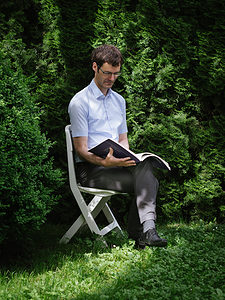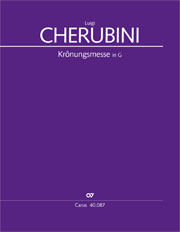Mysterious and Unapproachable
According to Sebastian Hammelbeck, the great moods make Luigi Cherubini’s “Cronation Mass” a real discovery.
When Sebastian Hammelbeck heard Luigi Cherubini’s Cronation Mass (Messe solennelle in G) for the first time a few years ago, it was a real discovery for him. From the first bars he was fascinated by the music …
When I heard Luigi Cherubini’s Coronation Mass (Messe solennelle) in G for the first time a few years ago, it was a real discovery for me. From the very first bars the music drew me in with its tremendous range of moods from liveliness and lightness to gravity and mourning, the play of sound colors and the completely unique, sometimes surprising style of musical interpretation of the text. An example of this unusual style is the beginning of the Credo, where Cherubini has female and male voices sing an ‘airy’ two-part canon, combined with a huge crescendo, the tension of which finally erupts as jubilation over the “descendit de coelis”. Or in the Gloria the praise at “Laudamus te …”, where the hymn-like tone at “Adoramus te” is suddenly interrupted and a quite different side of adoration, something mysterious and unapproachable, is expressed. As well as such contrasts, some of which are abrupt, the mass at the same time demonstrates a great formal unity and thematic concentration with its through-composed movements. This impression is reinforced by the fact that Cherubini relinquishes the use of vocal soloists, so that the whole text is sung by the choir, giving the work its own particular charm.
The Mass was composed in 1819 as a commission for the coronation of Louis XVIII. However, as the ceremony never took place, the work initially disappeared into a drawer, but received a few performances after 1820 before falling into oblivion for a long time. Only in 1987 was it once again performed.
Cherubini is still something of a well-guarded secret even now. But if nothing else, his Coronation Mass gives an idea of why he was so highly regarded – by Beethoven, for example – during his lifetime. In the music world he was a widely-recognized authority – it was no coincidence, for example, that Abraham Mendelssohn took his son, the 15-year-old Felix, straight to Cherubini in Paris to seek his opinion about the young composer’s talents. And in 1876, over three decades after his death, Cherubini was still regarded as “the greatest church music composer of this century” (Ferdinand Hiller).
For those seeking an alternative to, for example, the masses of Mozart or Haydn or to Beethoven’s C major Mass, I can therefore highly recommend Cherubini’s work.
Sebastian Hammelsbeck has been an editor at Carus since 2000. He has worked extensively at the Rheinberger Complete Edition, editions of sacred choral works by Joseph Haydn, Michael Haydn, Beethoven and others, and on organ music. As a part-time organist he plays regularly in church services, and he likes singing in the choir.





Leave a Reply
Want to join the discussion?Feel free to contribute!